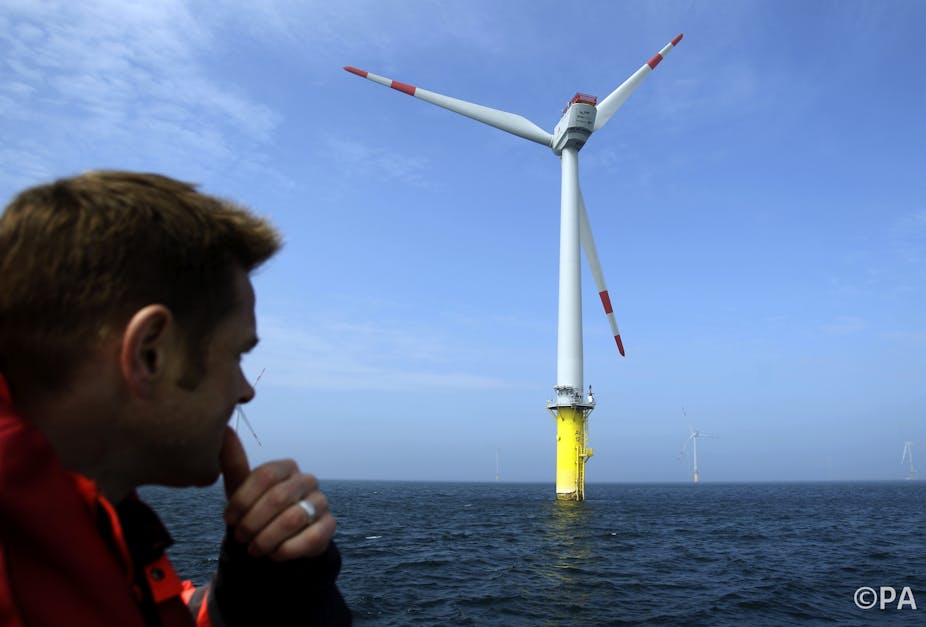The government has announced that the final prices paid to generators of solar, onshore and offshore wind would change to favour offshore wind at the expense of the others. While the difference is fairly slight – a fiver off here, a fiver added there – it reveals a favour that ignores the industry’s struggles to make offshore wind development economically viable.
In 2012 the global wind industry manufactured and installed more than 20,000 turbines generating 45GW of energy. The leading firm alone, Danish company Vestas, installed more than 6GW of this via 2,500 turbines. The company’s offerings centre on a “workhorse” platform that supports turbines from 1.8MW to 3MW and rotor sizes from 80-112m in diameter, to meet the needs of different sites with different wind conditions and remain cost effective. This cost effectiveness is made possible by a supply chain of factories and component makers that have through many very substantial investments been able to develop the rhythm and flow of work. A new family of turbines, of different size or specification, would require that investment and experience to be made all over again.
After more than a decade, the total number of offshore wind turbines worldwide is only now approaching 2,000 and growing erratically as different developers using different machinery from different countries embark on wholly unrelated and sometimes even interfering projects. This is not a route to any kind of cost effectiveness at all.
A joint venture between Vestas and Mitsubishi is developing a large, 8MW wind turbine but production won’t go ahead until there are sufficient orders to make it worthwhile. A leader in this month’s Windpower Monthly, the industry journal, explains that “collaboration is vital for offshore future” and that “the European wind industry continues to suffer from political indecision and backtracking on subsidies.” The UK is a particular offender for this, as shown by this week’s changing figures. Likewise Germany, which had intended to build more than 30GW of offshore capacity, now aims for 6.5GW – and only if the price is right, which it currently isn’t. Building things in the middle of the sea is very, very expensive, and that isn’t going to change.
Foundations all at sea
Pictures of offshore wind turbines look very much like those on land. But what lies beneath the water, and getting it there, is the problem. A standard Siemens 3.6MW turbine, rotor, gearbox, electronics and all, weighs around 250 tonnes. The steel tower that supports it when used on land weighs about 260 tonnes.
At the Dong Energy windfarm at Walney off the Cumbrian coast the water is 30m deep. A huge steel cylinder is driven 30m into the seabed – it weighs 600 tonnes, and comes from China. A connector sleeve that links the cylinder to the tower that is inserted into it weighs 300 tonnes, and also comes from China. These are very expensive and cost a great deal to put in place. Then there is the matter of bringing the electricity ashore. All in all, it’s expensive and energy intensive.
Challenging connections
Germany has four offshore wind farms connected to the grid, with each connected by cables of different voltages and substations of different designs – essentially what happened to be available at the time each system was ordered. More standardisation is needed to cut costs, but in truth the complexities of moving material out to sea, setting it up, and connecting high voltage equipment underwater, over 100 miles, will require many leaps in technology before offshore wind farms are robust and economical.
When asked what the wind power sector might look like ten years hence, Jonathan Cole, offshore managing director of Spanish firm Iberdrola said “unless offshore wind is 40% cheaper in a decade it won’t matter what the sector looks like, because offshore won’t be part of it.”
Little England
The UK holds 3.5% of the world’s wind energy capacity. About a third is offshore, but even this small amount accounts for more than half of all offshore wind installations on the planet. This is not a good place to be.
In the 1980s I created the designs, the manufacturing processes, the team and the company that made all the wind turbine blades in the UK. My old team is now the global blade technology development centre for Vestas on the Isle of Wight. I have many, many years experience in technology development of all sorts.
But with the exception of a few groups of engineers such as my old team, the UK seems to have no understanding of what developing wind technology involves. It is barely part of this 30-year-old industry that employs over 150,000 people in Europe alone, yet prides itself on having more than 50% of this tiny offshore non-market that the big boys in the real wind energy industry such as GE ignore, as it will never be good business. But the UK is so illiterate in these strategic technical matters, with an unruly market with unclear and changing policies, full of protesters ignorant of not only how the technology works, but what is required to sustain it as an economically viable industry.
Offshore wind is at best an area of research and development, not a real market. Even in its wildest dreams, offshore is a niche market, fraught with technical difficulty and seriously expensive. Instead the industry’s efforts are put to developing larger rotors and taller towers for its workhorse machines to generate more electricity at lower costs in southern Germany, for example, where the market is. It’s unlikely whether such developments, even with the best forward planning and standardisation, can ever make a good economic case for offshore wind over anything else, despite what the government hopes to achieve with its paltry financial incentives.

